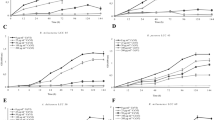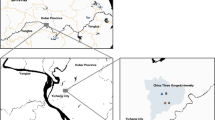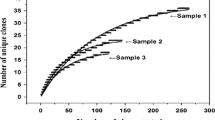Abstract
The potential for bioremediation of chromium pollution using bacteria was investigated in this study. Five chromium-removing bacteria strains were successfully isolated from Cr(VI)contaminated soils and identified by their 16S rRNA gene sequences. The optimum growth temperature (30–40 °C) and pH (8.5–11) for the five isolates were investigated. The effect of initial Cr(VI) concentrations (0–1,575 mg L−1) on bacterial growth was also studied. Results showed that Pseudochrobactrum saccharolyticum strain W1 had high chromium-removing ability and could grow at Cr(VI) concentrations from 0 to 1,225 mg L−1. To our knowledge, this is the first report of chromium removal by a member of the Pseudochrobactrum genus. Sporosarcina saromensis W5 had the highest chromium-removing rate of 0.79 mg h−1 mg−1 biomass. Exopolysaccharide (EPS) production and components of the five bacteria strains were also investigated, and a positive relationship was found between the bacterial chromium removal and EPS production.



Similar content being viewed by others
References
Badar, U., Ahmed, N., Beswick, A., Pattanapipitpaisal, P., & Macaskie, L. (2000). Reduction of chromate by microorganisms isolated from metal contaminated sites of Karachi, Pakistan. Biotechnology Letters, 22(10), 829–836.
Bafana, A. (2011). Mercury resistance in Sporosarcina sp. G3. Biometals, 24(2), 301–309.
Camargo, F., Okeke, F., & Frankenberger, B. (2003). Chromate reduction by chromium-resistant bacteria isolated from soils contaminated with dichromate. Journal of Environmental Quality, 32(4), 1228–1233.
Camargo, F. A. O., Okeke, B. C., Bento, F. M., & Frankenberger, W. T. (2005). Diversity of chromium-resistant bacteria isolated from soils contaminated with dichromate. Applied Soil Ecology, 29(2), 193–202.
Chen, J., Tang, Y.-Q., & Wu, X.-L. (2012). Bacterial community shift in two sectors of a tannery plant and its Cr (VI) removing potential. Geomicrobiology Journal, 29(3), 226–235.
Desai, C., Parikh, R. Y., Vaishnav, T., Shouche, Y. S., & Madamwar, D. (2009). Tracking the influence of long-term chromium pollution on soil bacterial community structures by comparative analyses of 16S rRNA gene phylotypes. Research In Microbiology, 160(1), 1–9.
Dubois, M., Gilles, K. A., Hamilton, J. K., Rebers, P., & Smith, F. (1956). Colorimetric method for determination of sugars and related substances. Analytical Chemistry, 28(3), 350–356.
Fein, J. B., Fowle, D. A., Cahill, J., Kemner, K., Boyanov, M., & Bunker, B. (2002). Nonmetabolic reduction of Cr (VI) by bacterial surfaces under nutrient-absent conditions. Geomicrobiology Journal, 19(3), 369–382.
Fendorf, S. E. (1995). Surface reactions of chromium in soils and waters. Geoderma, 67(1–2), 55–71.
Francisco, R., Alpoim, M., & Morais, P. (2002). Diversity of chromium resistant and reducing bacteria in a chromium contaminated activated sludge. Journal of Applied Microbiology, 92(5), 837–843.
Freire-Nordi, C. S., Vieira, A. A. H., & Nascimento, O. R. (2005). The metal binding capacity of Anabaena spiroides extracellular polysaccharide: an EPR study. Process Biochemistry, 40(6), 2215–2224.
Gehrke, T., Telegdi, J., Thierry, D., & Sand, W. (1998). Importance of extracellular polymeric substances from Thiobacillus ferrooxidans for bioleaching. Applied And Environmental Microbiology, 64(7), 2743–2747.
He, Z., Gao, F., Sha, T., Hu, Y., & He, C. (2009). Isolation and characterization of a Cr (VI)-reduction Ochrobactrum sp. strain CSCr-3 from chromium landfill. Journal of Hazardous Materials, 163(2–3), 869–873.
Ilhan, S., Nurbas, M., Kiliarslan, S., & Ozdag, H. (2004). Removal of chromium, lead and copper ions from industrial waste waters by Staphylococcus saprophyticus. Turkish Electronic Journal Biotechnology, 2, 50–57.
Jacobs, J. A., & Testa, S. M. (2005). Overview of chromium (VI) in the environment: background and history. In J. Guertin, J. A. Jacobs, & C. P. Avakian (Eds.), Chromium (VI) Handbook (pp. 1–21). Boca Raton: CRC Press.
Kampfer, P., Rossello-Mora, R., Scholz, H. C., Welinder-Olsson, C., Falsen, E., & Busse, H. J. (2006). Description of Pseudochrobactrum gen. nov., with the two species Pseudochrobactrum asaccharolyticum sp. nov. and Pseudochrobactrum saccharolyticum sp. nov. International Journal of Systematic and Evolutionary Microbiology, 56(8), 1823–1829.
Kampfer, P., Scholz, H., Huber, B., Thummes, K., Busse, H. J., Maas, E. W., et al. (2007). Description of Pseudochrobactrum kiredjianiae sp. nov. International Journal of Systematic and Evolutionary Microbiology, 57(4), 755–760.
Kampfer, P., Huber, B., Lodders, N., Warfolomeow, I., Busse, H. J., & Scholz, H. C. (2009). Pseudochrobactrum lubricantis sp. nov., isolated from a metal-working fluid. International Journal of Systematic and Evolutionary Microbiology, 59(10), 2464–2467.
Karkhanis, Y. D., Zeltner, J. Y., Jackson, J. J., & Carlo, D. J. (1978). A new and improved microassay to determine 2-keto-3-deoxyoctonate in lipopolysaccharide of Gram-negative bacteria. Analytical Biochemistry, 85(2), 595–601.
Kiran, B., & Kaushik, A. (2008). Chromium binding capacity of Lyngbya putealis exopolysaccharides. Biochemical Engineering Journal, 38(1), 47–54.
Liu, H., & Fang, H. H. (2002). Characterization of electrostatic binding sites of extracellular polymers by linear programming analysis of titration data. Biotechnology and Bioengineering, 80(7), 806–811.
Liu, Y. G., Xu, W. H., Zeng, G. M., Li, X., & Gao, H. (2006). Cr (VI) reduction by Bacillus sp. isolated from chromium landfill. Process Biochemistry, 41(9), 1981–1986.
McEldowney, S. (2000). The impact of surface attachment on cadmium accumulation by Pseudomonas fluorescens H2. Fems Microbiology Ecology, 33(2), 121–128.
McLean, J., & Beveridge, T. J. (2001). Chromate reduction by a pseudomonad isolated from a site contaminated with chromated copper arsenate. Applied and Environmental Microbiology, 67(3), 1076–1084.
Megharaj, M., Avudainayagam, S., & Naidu, R. (2003). Toxicity of hexavalent chromium and its reduction by bacteria isolated from soil contaminated with tannery waste. Current Microbiology, 47(1), 51–54.
Middleton, S. S., Latmani, R. B., Mackey, M. R., Ellisman, M. H., Tebo, B. M., & Criddle, C. S. (2003). Cometabolism of Cr (VI) by Shewanella oneidensis MR-1 produces cell-associated reduced chromium and inhibits growth. Biotechnology and Bioengineering, 83(6), 627–637.
Mistry, K., Desai, C., Lal, S., Patel, K., & Patel, B. (2010). Hexavalent chromium reduction by Staphylococcus sp. isolated from Cr(VI) contaminated land fill. International Journal of Biotechnology and Biochemistry, 6(1), 117–129.
Molokwane, P. E., Meli, K. C., & Nkhalambayausi-Chirwa, E. M. (2008). Chromium (VI) reduction in activated sludge bacteria exposed to high chromium loading: Brits culture (South Africa). Water Research, 42(17), 4538–4548.
Nguema, P. F., & Luo, Z. (2012). Aerobic chromium (VI) reduction by chromium-resistant bacteria isolated from activated sludge. Annals of Microbiology, 62(1), 41–47.
Ozturk, S., & Aslim, B. (2008). Relationship between chromium (VI) resistance and extracellular polymeric substances (EPS) concentration by some cyanobacterial isolates. Environmental Science and Pollution Research, 15(6), 478–480.
Ozturk, S., Aslim, B., & Suludere, Z. (2009). Evaluation of chromium (VI) removal behaviour by two isolates of Synechocystis sp. in terms of exopolysaccharide (EPS) production and monomer composition. Bioresource Technology, 100(23), 5588–5593.
Pal, A., & Paul, A. (2004). Aerobic chromate reduction by chromium-resistant bacteria isolated from serpentine soil. Microbiological Research, 159(4), 347–354.
Pattanapipitpaisal, P., Brown, N., & Macaskie, L. (2001). Chromate reduction by Microbacterium liquefaciens immobilised in polyvinyl alcohol. Biotechnology Letters, 23(1), 61–65.
Philip, L., Iyengar, L., & Venkobachar, C. (1998). Cr (VI) reduction by Bacillus coagulans isolated from contaminated soils. Journal of Environmental Engineering, 124(12), 1165–1170.
Priester, J. H., Olson, S. G., Webb, S. M., Neu, M. P., Hersman, L. E., & Holden, P. A. (2006). Enhanced exopolymer production and chromium stabilization in Pseudomonas putida unsaturated biofilms. Applied and Environmental Microbiology, 72(3), 1988–1996.
Raja, C. E., Anbazhagan, K., & Selvam, G. S. (2006). Isolation and characterization of a metal-resistant Pseudomonas aeruginosa strain. World Journal of Microbiology and Biotechnology, 22(6), 577–585.
Romanenko, L. A., Tanaka, N., Frolova, G. M., & Mikhailov, V. V. (2008). Pseudochrobactrum glaciei sp. nov., isolated from sea ice collected from Peter the Great Bay of the Sea of Japan. International Journal of Systematic and Evolutionary Microbiology, 58(10), 2454–2458.
Srinath, T., Verma, T., Ramteke, P., & Garg, S. (2002). Chromium (VI) biosorption and bioaccumulation by chromate resistant bacteria. Chemosphere, 48(4), 427–435.
Stanin, F. T. (2005). The transport and fate of chromium (VI) in the environment. In J. Guertin, J. A. Jacobs, & C. P. Avakian (Eds.), Chromium (VI) handbook (pp. 165–214). Boca Raton: CRC Press.
Stewart, D. I., Burke, I. T., Hughes-Berry, D., & Whittleston, R. (2008). Microbially-mediated chromate reduction in highly alkaline groundwater systems. Paper presented at the 1st International BioGeoCivil Engineering Conference, Delft, The Netherlands, 23–25 June.
Tamura, K., Dudley, J., Nei, M., & Kumar, S. (2007). MEGA4: molecular evolutionary genetics analysis (MEGA) software version 4.0. Molecular Biology and Evolution, 24(8), 1596–1599.
Thacker, U., Parikh, R., Shouche, Y., & Madamwar, D. (2006). Hexavalent chromium reduction by Providencia sp. Process Biochemistry, 41(6), 1332–1337.
Torino, M., Taranto, M., Sesma, F., & De Valdez, G. (2001). Heterofermentative pattern and exopolysaccharide production by Lactobacillus helveticus ATCC 15807 in response to environmental pH. Journal of Applied Microbiology, 91(5), 846–852.
Viti, C., Pace, A., & Giovannetti, L. (2003). Characterization of Cr (VI)-resistant bacteria isolated from chromium-contaminated soil by tannery activity. Current Microbiology, 46(1), 1–5.
Wang, Y. T., & Xiao, C. (1995). Factors affecting hexavalent chromium reduction in pure cultures of bacteria. Water Research, 29(11), 2467–2474.
Wang, G., Huang, L., & Zhang, Y. (2008). Cathodic reduction of hexavalent chromium [Cr (VI)] coupled with electricity generation in microbial fuel cells. Biotechnology Letters, 30(11), 1959–1966.
Weisburg, W. G., Barns, S. M., Pelletier, D. A., & Lane, D. J. (1991). 16S ribosomal DNA amplification for phylogenetic study. Journal of Bacteriology, 173(2), 697–703.
Wu, Y., Xia, L., Yu, Z., Shabbir, S., & Kerr, P. G. (2014). In situ bioremediation of surface waters by periphytons. Bioresource Technology, 151, 367–372.
Yao, Y., Guan, J., Tang, P., Jiao, H., Lin, C., Wang, J., et al. (2010). Assessment of toxicity of tetrahydrofuran on the microbial community in activated sludge. Bioresource Technology, 101(14), 5213–5221.
Yewalkar, S. N., Dhumal, K. N., & Sainis, J. K. (2007). Chromium (VI)-reducing Chlorella spp. isolated from disposal sites of paper-pulp and electroplating industry. Journal of Applied Phycology, 19(5), 459–465.
Yumoto, I., Hirota, K., Nodasaka, Y., & Nakajima, K. (2005). Oceanobacillus oncorhynchi sp. nov., a halotolerant obligate alkaliphile isolated from the skin of a rainbow trout (Oncorhynchus mykiss), and emended description of the genus Oceanobacillus. International Journal of Systematic and Evolutionary Microbiology, 55(4), 1521–1524.
Zhu, W., Yang, Z., Ma, Z., & Chai, L. (2008). Reduction of high concentrations of chromate by Leucobacter sp. CRB1 isolated from Changsha, China. World Journal of Microbiology and Biotechnology, 24(7), 991–996.
Acknowledgment
The authors would like to thank Dr. Allyson Brady at the University of Calgary for her help in improving the paper. This work was financially supported by the National Natural Science Foundation of China (no. 31370053).
Author information
Authors and Affiliations
Corresponding author
Rights and permissions
About this article
Cite this article
He, Z., Li, S., Wang, L. et al. Characterization of Five Chromium-Removing Bacteria Isolated from Chromium-Contaminated Soil. Water Air Soil Pollut 225, 1904 (2014). https://doi.org/10.1007/s11270-014-1904-2
Received:
Accepted:
Published:
DOI: https://doi.org/10.1007/s11270-014-1904-2




